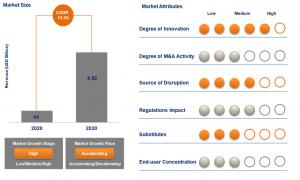
Global carbon composite hydrogen tanks market is projected to reach USD 4.52 billion by 2030, growing at a CAGR of 10.2%
The "Global Carbon Composite Hydrogen Tanks Market by Tank Type, by Process Type, by Application, and by Regions - Forecast to 2030" by Tersus Strategy
MILWAUKE, WISCONSIN, USA, September 21, 2022 /EINPresswire.com/ -- The "Global Carbon Composite Hydrogen Tanks Market by Tank Type (Type III and Type IV), by Process Type (Wet Winding and Dry Winding), by Application (Transportation, Distribution, and Hydrogen Refueling Stations), and by Regions - Forecast to 2030" report has been added to Tersus Strategy’s offering.
Cryogenic composite tank development began in 1987. First, most of the effort has been devoted to liquid hydrogen tanks mainly because liquid hydrogen tanks are larger than liquid oxygen tanks, lightweight materials would provide a proportionately greater weight reduction.
For years, carbon fiber-reinforced polymer (CFRP) composites have offered lightweight storage of compressed hydrogen (H2) gas for zero-emission, fuel cell-powered vehicles via Type IV tanks comprising plastic liners wrapped with carbon fiber and epoxy resin. Though H2 has long promised a sustainable source of clean energy, until recently, progress was slow. However, growth projections for Type IV tanks are tremendous.
CFRC have advantages in high strength-to-weight and high stiffness-to-weight ratios. The key benefits of using composites make these hydrogen storage tanks light-weight, with long-term potential, a clean and safe energy carrier, having large-scale storage and improved life cycle.
For more information about this report visit: https://tersusstrategy.com/product/global-carbon-composite-hydrogen-tanks-market-2022-2030/
Transportation segment, by application, is projected to be the largest market during the forecast period: High-pressure gas storage vessels represent one of the biggest and fastest-growing markets for advanced composites, particularly for filament wound carbon fibre composites. They have a use in a variety of industries, amongst which is the automotive industry and its hydrogen-powered vehicles.
The transportation segment is likely to hold undeniable dominance in the market throughout the forecast period, driven by the most sought-after FCEVs. The key fuel cell cars on the road, incessantly adding momentum to the market are Toyota Mirai, Hyundai Nexo, and Honda Clarity.
Asia-Pacific is anticipated to dominate the global market till 2030, whereas Europe is likely to experience the highest growth in the market during the forecast period: China and Japan have announced targets of 1 million and 800,000 FCV in operation, respectively, by 2030, while Korea says it will convert all commercial vehicles to hydrogen by 2025 and targets 6.2 million FCV produced by 2040. Notably, these are all countries with significant carbon fiber production.
For more information about this report visit: https://tersusstrategy.com/product/global-carbon-composite-hydrogen-tanks-market-2022-2030/
Key Topics Covered:
1. Report Scope
1.1. Market Segmentation and scope
1.2. Regional Scope
1.3. Estimates and forecast timeline
2. Market Research Methodology
2.1. Research methodology and design
2.2. Sample selection
2.3. Reliability and validity
3. Executive Summary
4. Market Analysis
4.1. Market size and growth rates
4.2. Market growth drivers, market dynamics and trends
4.3. Market scenarios and opportunity forecasts
4.4. Market constraints and challenges
4.5. Regional & national hydrogen strategy
4.6. Industry value chain analysis
4.7. Industry analysis – Porter’s
4.7.1. Threat of new entrants
4.7.2. Bargaining power of suppliers
4.7.3. Bargaining power of buyers
4.7.4. Threat of substitutes
4.7.5. Competitive rivalry
4.8. PEST analysis
4.8.1. Political/legal landscape
4.8.2. Economic landscape
4.8.3. Social landscape
4.8.4. Technological landscape
5. Market Breakdown – by Tank Type
5.1. Introduction
5.2. Type III
5.3. Type IV
6. Market Breakdown – by Process Type
6.1. Introduction
6.2. Wet Winding
6.3. Dry Winding
7. Market Breakdown – by Application
7.1. Introduction
7.2. Transportation
7.2.1. Cars
7.2.2. Trucks
7.2.3. Aviation
7.2.4. Marine
7.2.5. Rail
7.2.6. Others
7.3. Distribution
7.4. Hydrogen Refueling Stations (HRS)
8. Market Breakdown – by Geography
8.1. North America
8.1.1. North America Carbon Composite Hydrogen Tanks Market, 2022-2030
8.1.2. North America Carbon Composite Hydrogen Tanks Market, by Tank Type
8.1.3. North America Carbon Composite Hydrogen Tanks Market, by Process Type
8.1.4. North America Carbon Composite Hydrogen Tanks Market, by Application
8.1.5. North America Carbon Composite Hydrogen Tanks Market, by Country
8.1.5.1. U.S.
8.1.5.2. Rest of North America
8.2. Europe
8.2.1. Europe Carbon Composite Hydrogen Tanks Market, 2022-2030
8.2.2. Europe Carbon Composite Hydrogen Tanks Market, by Tank Type
8.2.3. Europe Carbon Composite Hydrogen Tanks Market, by Process Type
8.2.4. Europe Carbon Composite Hydrogen Tanks Market, by Application
8.2.5. Europe Carbon Composite Hydrogen Tanks Market, by Country
8.2.5.1. Germany
8.2.5.2. Italy
8.2.5.3. Norway
8.2.5.4. Rest of Europe
8.3. Asia-Pacific
8.3.1. APAC Carbon Composite Hydrogen Tanks Market, 2022-2030
8.3.2. APAC Carbon Composite Hydrogen Tanks Market, by Tank Type
8.3.3. APAC Carbon Composite Hydrogen Tanks Market, by Process Type
8.3.4. APAC Carbon Composite Hydrogen Tanks Market, by Application
8.3.5. APAC Carbon Composite Hydrogen Tanks Market, by Country
8.3.5.1. China
8.3.5.2. Japan
8.3.5.3. South Korea
8.3.5.4. Rest of APAC
8.4. Rest of World
8.4.1. RoW Carbon Composite Hydrogen Tanks Market, 2022-2030
8.4.2. RoW Carbon Composite Hydrogen Tanks Market, by Tank Type
8.4.3. RoW Carbon Composite Hydrogen Tanks Market, by Process Type
8.4.4. RoW Carbon Composite Hydrogen Tanks Market, by Application
8.4.5. RoW Carbon Composite Hydrogen Tanks Market, by Country
8.4.5.1. Latin America
8.4.5.2. Others
9. Competitive Landscape
9.1. Company Market Positioning
9.2. Company Geographical Presence Analysis
9.3. Market Revenue Share Analysis (%), by Leading Players
10. Company Profiles
• Company Overview
• Financial Performance
• Product Benchmarking
• Recent Developments
10.1. Hexagon Purus
10.2. Plastic Omnium
10.3. Luxfer Holdings PLC
10.4. Iljin Composites Co., Ltd.
10.5. Worthington Industries, Inc.
10.6. Faurecia (FORVIA)
10.7. Universal Hydrogen
10.8. Faber Industrie SpA
10.9. Quantum Fuel Systems LLC
10.10. NPROXX B.V.
10.11. Steelhead Composites, Inc.
10.12. Hanwha Cimarron
For more information about this report visit: https://tersusstrategy.com/product/global-carbon-composite-hydrogen-tanks-market-2022-2030/
Kevin Matthew
Tersus Strategy
+1 414-882-8941
email us here
EIN Presswire does not exercise editorial control over third-party content provided, uploaded, published, or distributed by users of EIN Presswire. We are a distributor, not a publisher, of 3rd party content. Such content may contain the views, opinions, statements, offers, and other material of the respective users, suppliers, participants, or authors.



